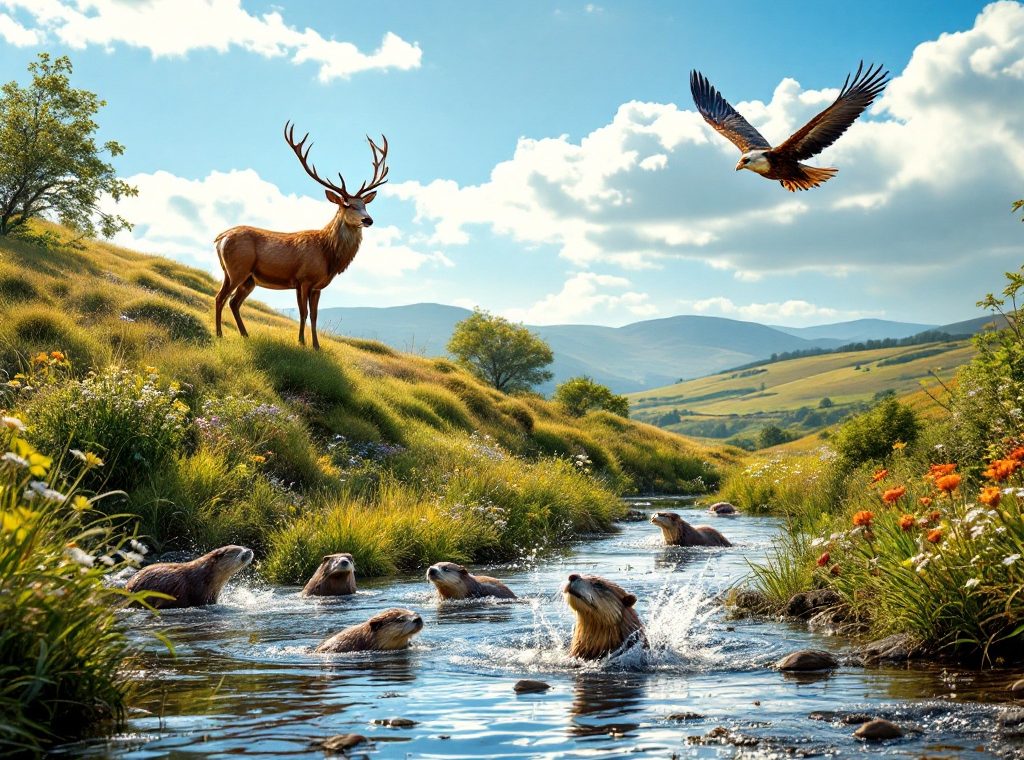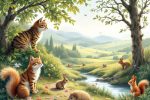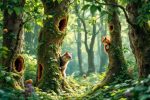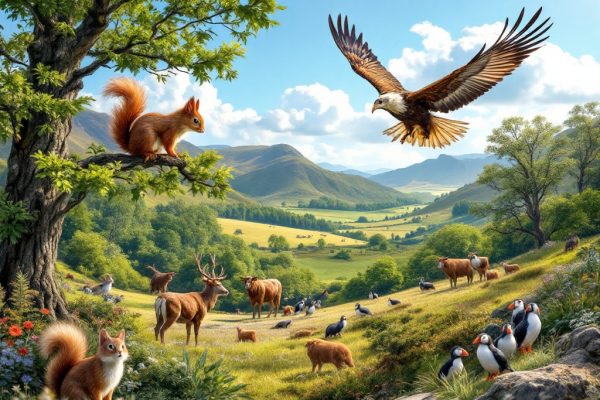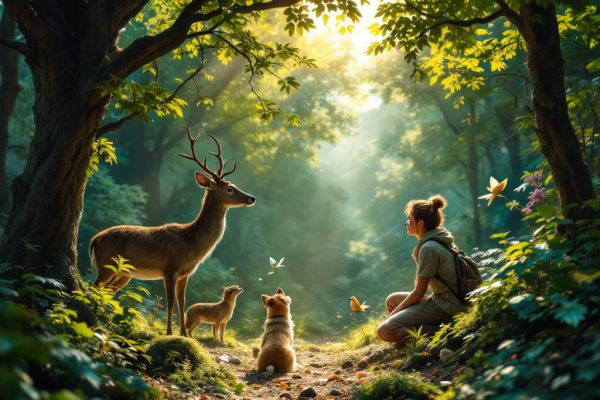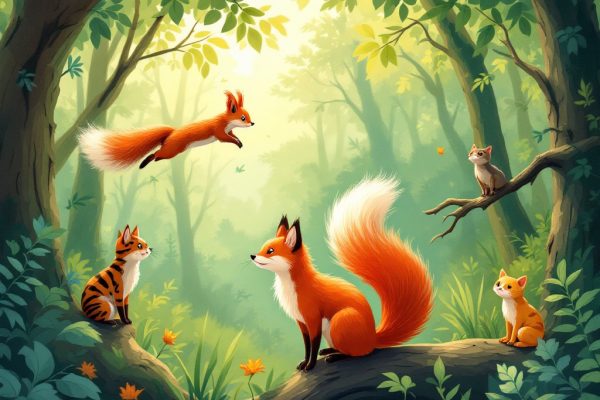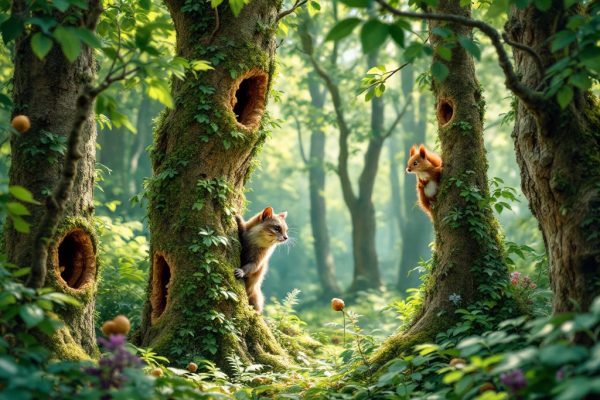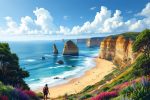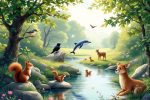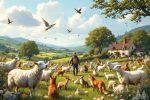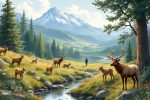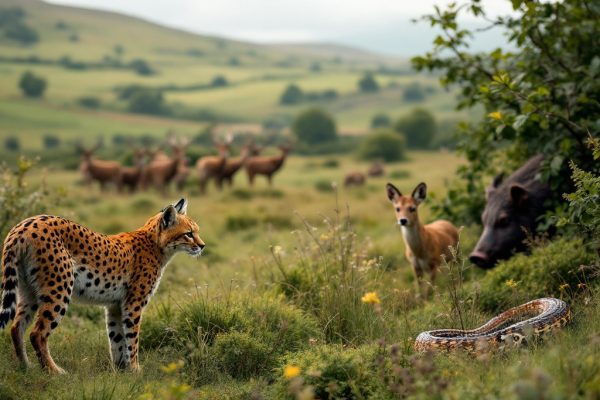Native Fauna of a Lothian Region: Important Facts
Discover the vibrant wildlife of Lothian, Scotland, from red deer in the hills to otters playing in the rivers. This region boasts a rich tapestry of species, including majestic golden eagles and elusive Scottish wildcats. But these native animals face challenges. Explore Lothian’s crucial wildlife reserves and learn how conservation efforts, like beaver reintroduction and red kite protection programs, are making a difference. Dive in to discover how you can support Lothian’s natural heritage for future generations.
Important information
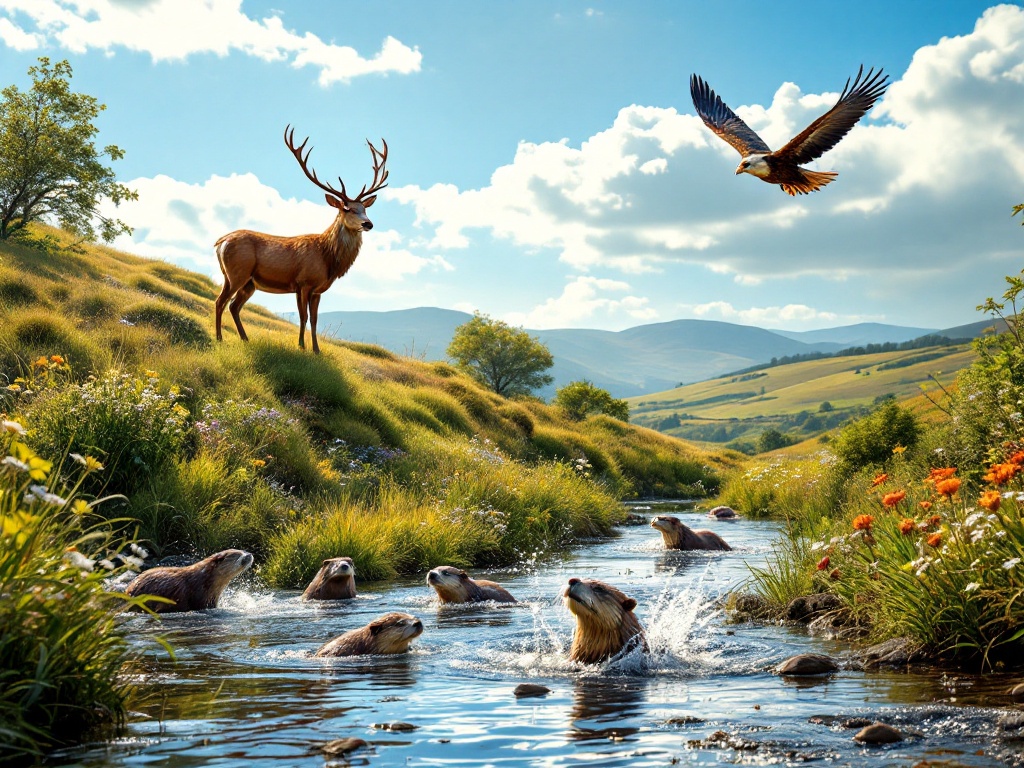
- Lothian, Scotland, has diverse wildlife, from red deer and otters to various birds, reptiles, amphibians, and insects.
- Wildlife reserves and conservation efforts are crucial for protecting native species like the red squirrel and great crested newt.
- Educational programs raise public awareness about Lothian’s unique ecosystems and the importance of conservation.
- Reintroduced Eurasian beavers significantly impact Lothian’s ecosystems by creating wetlands that support biodiversity.
- Invasive species like the grey squirrel and American mink threaten native wildlife and their habitats.
Introduction to the Native Fauna of a Lothian Region
Lothian showcases Scotland’s diverse wildlife, from its coastal shores to its forests. Red deer grace the hills, otters frolic in the rivers, and badgers burrow into the earth. These mammals represent just a fraction of Lothian’s inhabitants. The region’s birdlife is equally remarkable, with barn owls hunting silently and Scottish crossbills flitting through the trees. Reptiles, amphibians, and insects further enrich this bustling ecosystem. However, these native species face many challenges, making conservation efforts essential to protect Lothian’s natural heritage and its vital habitats.
Understanding the Natural Heritage of Lothian
Lothian’s natural heritage is a vibrant tapestry of diverse habitats and species. Protecting this biodiversity is crucial, and wildlife reserves serve as vital sanctuaries for native animals. Within these protected areas, creatures ranging from mammals and birds to reptiles, amphibians, and insects find refuge. Educational initiatives also play a key role in raising public awareness about Lothian’s unique ecosystems and the importance of conservation. These programs foster community involvement and promote responsible interaction with the natural world. For example, the Scottish Wildlife Trust actively manages reserves, conducts essential research, and champions the protection of vulnerable species. Continued support for these efforts is essential to ensure that Lothian’s natural beauty endures for generations to come.
Wildlife Reserves and Their Importance
Lothian’s wildlife reserves protect essential habitats for diverse species, including the red squirrel and great crested newt. This protection ensures their survival and promotes biodiversity. These reserves also offer educational programs and recreational activities, fostering appreciation for Lothian’s natural heritage.
Species Finder: Discovering Lothian’s Fauna
Lothian’s wildlife flourishes from woodlands to shores. Deer roam the forests, otters play in the rivers, and badgers make their homes in the earth. Above, eagles soar, owls hunt, and puffins dot the coastline. However, Lothian’s vibrant fauna isn’t limited to these larger animals. A rich diversity of reptiles, amphibians, and insects also contributes to the region’s biodiversity. Protecting these diverse habitats and the species within them is crucial for Lothian’s future.
Education and Wildlife Awareness Programs
Lothian’s wildlife awareness programs educate the public about native animals and their conservation. A strong focus is placed on endangered species and habitat protection. Through community involvement and education, these programs promote sustainable living. Local organizations collaborate with authorities, seeking to balance development with wildlife preservation. Vital conservation efforts include restoring habitats, establishing wildlife corridors, and designating protected areas. Population monitoring and educational initiatives are also essential.
Programs’ Focus
- educating the public about native animals,
- conserving native animal populations,
- protecting endangered species,
- preserving habitats.
Key Conservation Efforts
- restoring habitats,
- establishing wildlife corridors,
- designating protected areas,
- monitoring populations,
- implementing educational initiatives.
Key Mammals in the Lothian Region
Britain’s largest deer, the red deer, roams the land with majesty and grace.
Adaptable mountain hares thrive in the uplands, their camouflage shifting with the seasons.
The Scottish wildcat, Britain’s sole surviving native feline, is a fierce predator, yet it fights a constant battle for survival.
Red squirrels face a formidable foe in the invasive grey squirrel, which not only outcompetes them for resources but also carries a deadly disease.
Hope remains, however, in the form of the agile pine marten, a skilled climber that preys on grey squirrels, offering protection to the native reds.
The reintroduction of Eurasian beavers has also had a profound impact, transforming landscapes and creating vital habitats. Their dams, for instance, form wetlands that support a diverse array of wildlife.
Red Deer: Britain’s Largest Deer
Red deer, Britain’s largest deer species, play a vital role in Lothian’s wildlife, contributing significantly to the region’s ecological balance.
Mountain Hare: Adapted to Upland Areas
Mountain hares thrive in Lothian’s uplands, especially on the heather moorlands. Their remarkable adaptations make these areas ideal habitats, allowing them to flourish in these demanding environments.
Scottish Wildcat: Britain’s Last Native Cat Species
The Scottish wildcat (Felis silvestris grampia), Britain’s last native cat, is critically endangered and requires immediate conservation action. Its presence is essential to the Lothian region’s ecosystem, where it plays a vital ecological role.
Red Squirrel: Threatened by Grey Squirrels
Grey squirrels carry a deadly virus called squirrelpox, which is devastating to red squirrel populations. This disease is a primary factor in their decline, making conservation efforts in Scotland crucial for their survival.
Pine Marten: Ally to the Red Squirrel
Pine martens play a crucial role in the survival of red squirrels by preying on grey squirrels. Grey squirrels pose a double threat to red squirrels: they outcompete them for resources and carry squirrelpox, a deadly virus for reds.
The pine marten’s predation helps control grey squirrel numbers, creating space for red squirrel populations to recover. In areas where pine martens thrive, red squirrels experience greater stability and a reduced threat from squirrelpox, giving them crucial protection.
Eurasian Beaver: Reintroduction and Impact
Reintroduced to Scotland in 2009 after a 400-year hiatus, Eurasian beavers have significantly impacted Lothian’s ecosystems. Their dam-building activities create vital wetlands, supporting a diverse range of wildlife, including fish, amphibians, and invertebrates. Furthermore, the beavers’ presence enhances biodiversity and improves water quality.
Birds of Prey and Other Avian Species
Lothian offers diverse habitats ranging from uplands to coastlines, supporting a rich variety of birdlife, including several impressive raptors. Scotland’s largest bird of prey, the golden eagle, hunts mountain hares and grouse in the upland areas. The native pinewoods shelter capercaillie, a large grouse species. Along Lothian’s coasts and estuaries, the reintroduced white-tailed eagle soars majestically. Thanks to conservation efforts, red kites, once a rarity, are becoming a more frequent sight. During the summer months, ospreys grace the skies, breeding and hunting fish, adding yet another dimension to Lothian’s vibrant avian population.
Golden Eagle: Scotland’s Deadliest Predator
Golden eagles are Scotland’s most impressive aerial hunters. These majestic raptors typically mate for life, demonstrating remarkably strong pair bonds. They return to the same nests annually, and sometimes even across generations. This nesting site fidelity plays a crucial role in the Lothian ecosystem’s stability, ensuring these magnificent birds continue gracing Scotland’s skies.
Capercaillie: Inhabitants of Native Pinewoods
The capercaillie, an impressively large grouse, inhabits the ancient Caledonian pine forests. It sustains itself on a diet of pine needles, berries, and insects. Sadly, their numbers have dwindled due to habitat loss and fragmentation. Conservationists are working to restore these habitats and control predators. Protecting these magnificent birds demands continued dedication.
White-Tailed Eagle and Its Habitat
White-tailed eagles inhabit coastal and large lakeside habitats. Their diet mainly consists of fish and seabirds. The presence of these majestic birds indicates a thriving, balanced ecosystem.
Red Kite and Conservation Efforts
Red kites are flourishing in Lothian, thanks to ongoing conservation efforts like population monitoring and protection. These measures help ensure these magnificent birds continue soaring through the region’s skies, promising a bright future.
Osprey and Its Migration Patterns
Ospreys are renowned for their epic migrations between their breeding grounds in Scotland (including Lothian) and their wintering havens in West Africa. Their presence in Lothian is a testament to the region’s vibrant avian diversity.
Marine and Aquatic Wildlife
Scottish waters are home to a variety of fascinating marine life. The basking shark, the largest fish in the region, feeds on plankton. Bottlenose dolphins frequently visit the shores of Lothian. Grey seals are a common sight along the coast. Lothian’s waters also provide a haven for the protected great crested newt.
Basking Shark: Largest Fish in Scottish Waters
The basking shark, the second-largest fish globally, reigns supreme in Scottish waters. This gentle giant, a slow-moving filter feeder, sustains itself on plankton. It is a frequent visitor along the Lothian coastline, playing a crucial role in the marine ecosystem.
Bottlenose Dolphin: Frequent Visitors to Lothian Shores
Bottlenose dolphins are a frequent sight along Scotland’s Lothian coast, adding to the area’s rich wildlife and captivating both residents and visitors. These intelligent creatures play a vital role in the local ecosystem.
Grey Seal: Common Sights Along the Coast
Grey seals are a common sight along the Lothian coast, playing a vital role in the marine ecosystem and offering fantastic wildlife viewing opportunities.
Great Crested Newt: Protected Amphibian Species
In Lothian, the great crested newt (Triturus cristatus) is a protected species under the Wildlife and Countryside Act 1981. This legislation safeguards the newts, their habitats, breeding sites, and places of rest. Capturing, killing, or disturbing them is illegal.
Conservation and Protection of Lothian’s Wildlife
Lothian protects its diverse wildlife through habitat restoration and species monitoring. Raising public awareness is also key. Organizations work with local authorities to protect woodlands, wetlands, and coastal regions, mitigating the impact of urban expansion and climate change. Creating wildlife corridors and protected areas, along with educational programs that promote community awareness and sustainable practices, are essential for preserving native species and enhancing biodiversity. This requires ongoing dedication to protect Lothian’s natural heritage.
Endangered Species and Their Protection
Lothian’s diverse wildlife flourishes due to dedicated conservation work. This involves preserving and restoring key habitats, enabling animals such as the Scottish wildcat and red squirrel to thrive. Creating wildlife corridors, for instance, allows for greater movement and genetic exchange. Public education is also crucial, fostering community involvement and promoting responsible environmental stewardship. These combined initiatives help ensure Lothian’s natural heritage continues to prosper.
Role of Wildlife Charities and NatureScot
NatureScot leads Scotland’s nature conservation efforts, advising the government on crucial protection strategies. Wildlife charities like the Scottish Wildlife Trust and the RSPB also play a vital role. They manage nature reserves, conduct research, and educate the public about Scotland’s diverse wildlife. These organizations frequently collaborate on impactful projects, such as species reintroduction and habitat restoration, working together to protect Scotland’s natural heritage.
Impact of Invasive Species
Invasive species are wreaking havoc on Lothian’s natural ecosystems, competing with native animals for vital resources like food and shelter. This competition has dire consequences, leading to dwindling native populations and a decline in biodiversity. Invasive plants further compound the problem by transforming habitats, rendering them unsuitable for native wildlife.
Example of Invasive Species
The grey squirrel displaces the native red squirrel.
Impact on Native Wildlife
The American mink preys on vulnerable water voles and ground-nesting birds.
These invaders significantly impact Lothian’s environment.
Wildlife Legislation and Management
Lothian’s wildlife laws safeguard local animals and their habitats, guiding crucial conservation efforts. These regulations focus on endangered species and threatened ecosystems, managing hunting and fishing practices to ensure sustainable populations. Enforcement is led by NatureScot, which collaborates with other authorities and charities to preserve Lothian’s natural heritage. Key legislation, like the Wildlife and Countryside Act 1981, offers broad protection. Specific laws target certain animals, such as the great crested newt. These measures balance human activity with the needs of Lothian’s diverse wildlife, ensuring its continued survival.
Ecology Surveys and Habitat Protection
Ecology surveys are essential for protecting Lothian’s wildlife and their habitats. They examine species distribution, abundance, and health, providing data that informs key decisions about habitat restoration and species recovery programs. This information also helps establish protected areas and monitor the effectiveness of conservation efforts. Habitat protection measures, based on survey results, aim to improve Lothian’s ecosystems by restoring damaged areas and controlling invasive species. These surveys contribute to sustainable land management and the preservation of Lothian’s natural heritage.
Natural Engineers: The Role of Beavers
Beavers, nature’s engineers, construct dams that create vital wetlands. These wetlands support a diverse range of plant and animal life, boosting biodiversity.

